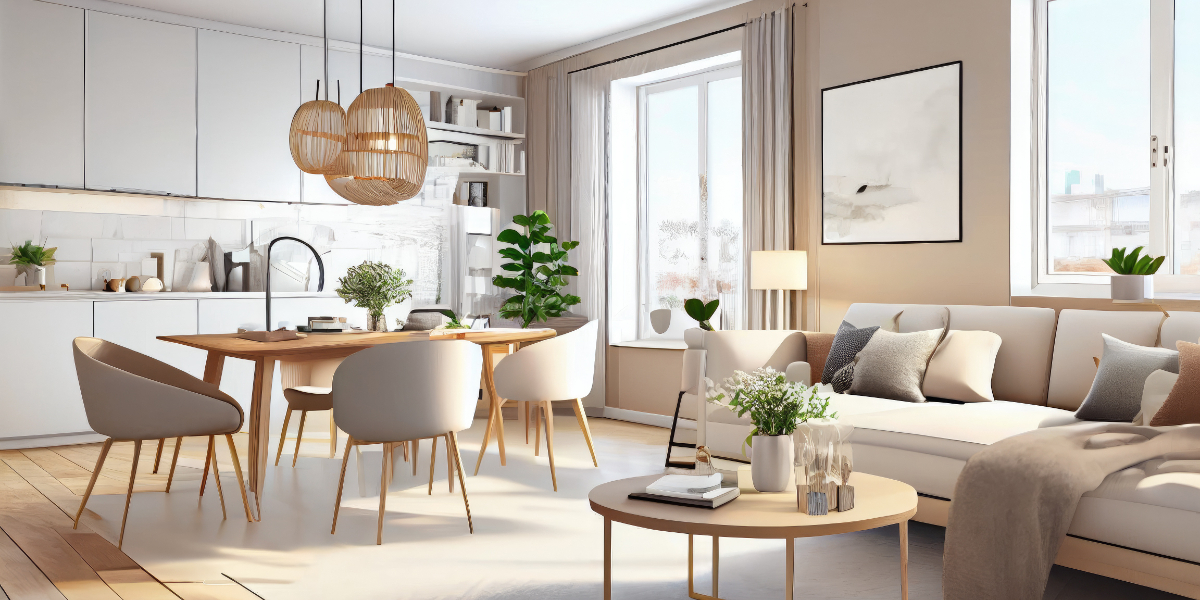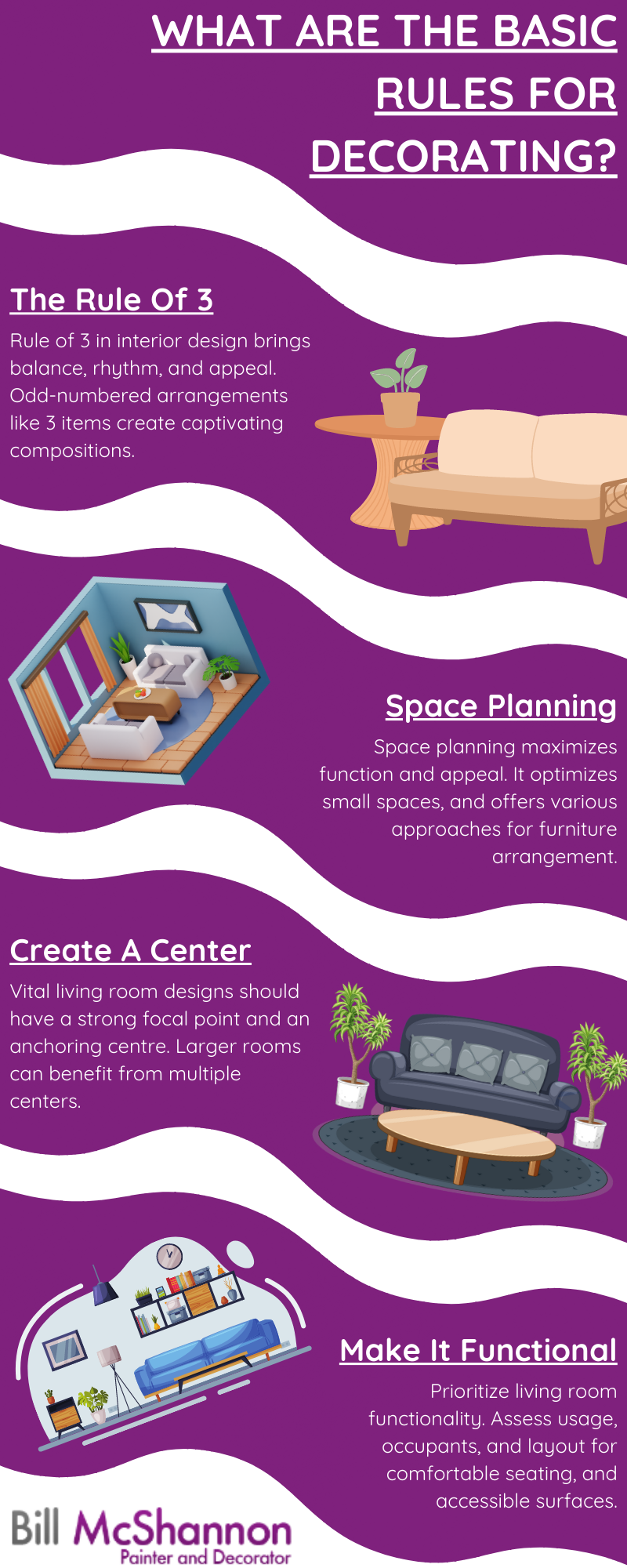What are the basic rules for decorating? From colour coordination to furniture arrangement, explore essential tips to transform any room into a stylish haven. Bill McShannon Painter & Decorator offer interior house decorating services in Stockport. Learn how balance, proportion, and functionality play key roles in effective decoration.
Basic Rules Of Interior Design
Step into the fascinating world of interior design, where the art of creativity meets the science of functionality to craft captivating living spaces. Whether you're an experienced designer or a novice eager to embark on your interior decor journey, grasping the fundamental rules of design is crucial for curating spaces that exude beauty and purpose.
In this comprehensive article, we'll delve into the basic principles that govern interior design, unlocking the secrets to transforming ordinary rooms into extraordinary sanctuaries.
Discover the power of colour, texture, balance, and proportion as we unravel the secrets behind creating harmonious and inviting interiors that reflect your individual style and cater to your unique lifestyle needs.
So, let's immerse ourselves in the captivating world of interior design, where innovation and imagination know no bounds, and let your creative spirit soar. Get ready to be inspired and empowered as we embark on a journey of exploration through the endless possibilities of interior design.
Basic Decorating Rules
The Rule Of 3
The rule of 3 is an essential and foundational principle that significantly impacts every aspect of interior design, encompassing not just the layout of a room but also the choice of furniture, colours, and patterns.
Often referred to as the golden rule or golden ratio of interior design, it creates a sense of balance, rhythm, and visual appeal in any space. While technically applicable to various design elements, it finds its most popular application in arranging vignettes with groups of 3 items.
Instead of limiting ourselves to a specific number, we can think of this as the "rule of odds," where the arrangement of items in odd numbers, particularly three, captures the senses and creates a more captivating and visually stimulating composition.
Of course, groups of 5, 7, or 9 can also work wonders, depending on the nature of the arrangement and the overall design theme.

Space Planning
At the core of a well-designed interior is meticulous space planning, an essential step that might not sound glamorous but is fundamental to creating a functional and visually appealing room. Space planning allows you to make the most of every nook and cranny, a crucial consideration, especially in smaller spaces where optimisation is key.
Moreover, effective space planning enhances traffic flow and ensures seamless functionality within the room. There are multiple approaches to space planning, each offering its unique advantages. One method involves measuring your room and sketching it on graph paper.
Measure each piece of furniture, then cut out corresponding pieces of cardboard or paper to represent them. Keep the proportions of the furniture consistent with the scale on the graph paper. By moving these cut-outs around on paper, you can explore different furniture arrangements until you find one that suits your taste and needs.
Find Your Room's Focal Point
In conjunction with the principles of space planning, identifying the focal point of your room is essential to achieving a well-balanced and cohesive design. The focal point serves as the centrepiece of your space, instantly capturing the attention of anyone entering the room. It establishes the visual hierarchy and sets the tone for the overall decor.
A focal point can take various forms, ranging from prominent architectural features like fireplaces, large windows, or elegant molding, to striking pieces of furniture or eye-catching artwork. Any element that immediately draws your eye upon entering the room can serve as a focal point.
Choose Your Fabric & Rugs First
Selecting fabrics and rugs before deciding on paint colours is a smart approach that streamlines the design process and ensures a harmonious and cohesive look. Fabrics and rugs offer a rich array of colours, patterns, and textures, making them a valuable source of inspiration for your room's colour scheme.
When you begin your design journey with fabrics and rugs, you have a vast palette of colours and patterns to work with, allowing you to easily find paint colours that complement and enhance these foundational elements. Additionally, fabrics and rugs often feature various shades and tones that can be matched with paint colours to create a seamless and well-coordinated aesthetic.
Create A Centre
Every well-designed living room benefits from a strong focal point, but equally crucial is creating a centre that anchors the space and guides the layout. Whether it's a coffee table, an ottoman, or a group of chairs, the centre of your living room demands attention and forms the heart of the design.
For larger living rooms, consider incorporating multiple centres, such as a coffee table at one end and an additional seating area at the other end. This multifaceted approach ensures that every corner of the room feels inviting and well-utilised.
Less Is More
The age-old adage "less is more" holds true in interior design, emphasising the importance of maintaining a sense of balance and avoiding visual clutter.
While some may prefer a minimalistic approach with clean lines and uncluttered spaces, others may opt for a more maximalist style with an abundance of decor and ornate details.
Regardless of your preference, striking the right balance is key to creating a harmonious and inviting space. If you lean towards a more minimalistic style, embracing simplicity and clean lines will create a serene and tranquil atmosphere.
Focus on essential pieces of furniture and decor items, allowing each element to shine without competing for attention. Remember that every item in the room serves a purpose and contributes to the overall aesthetic.

Make It Functional
When designing a living room, functionality should always be at the forefront of your considerations. Begin by evaluating how the room will be used and the number of people who will be using it regularly. This will help you determine the appropriate style, size, and quantity of furnishings required.
Arranging the furniture to facilitate conversation and traffic flow is essential in creating a functional living room. Ensure that seating options are comfortably accessible, allowing occupants to engage with each other effortlessly. Place side tables within easy reach of seating areas to provide convenient surfaces for drinks, books, and other essentials.
Select Scaled Pieces
Achieving a sense of balance and proportion in your living room involves selecting scaled pieces that complement each other. Incorporating furniture of varying sizes and heights helps create an aesthetically pleasing environment. Start by placing larger pieces, such as sofas or sectionals, and then arrange smaller items around them.
Maintaining a sense of visual harmony is crucial in scaling your pieces. If you have a large sectional sofa, consider pairing it with a smaller coffee table and side tables to achieve a balanced look. This interplay of proportions ensures that each piece has its space while contributing to the overall design.
Add Dimension
Texture and dimension play a vital role in elevating your living room's visual appeal and interest. While decorative pieces are typically the final touches in a space, they are essential in creating height and depth. Adding artwork, photos, shelves, or mirrors to the walls introduces dimension and texture to your living room.
When hanging art or decor on the wall, consider their height from the wall edge and the ceiling, aiming to keep them at eye level and centred. This strategic placement ensures that your decor is not only visually appealing but also easily accessible for viewing.
Add An Area Rug
An often overlooked but indispensable element in living room design is the area rug. Not only does an area rug add texture and dimension to a space, but it also serves a functional purpose in delineating different seating areas and tying the room together.
When selecting an area rug, choose one that complements your colour scheme and fits well within the room. To maintain visual balance, a general rule is to have at least the front legs of your furniture on the rug, at a distance of 6 to 12 inches from the walls.
Incorporate Lighting
Layering light sources is a fundamental aspect of creating a bright and inviting living room. Even if you have a primary overhead light, incorporate various styles of light fixtures, such as lamps on side tables, accent lighting within bookshelves, and even candles.
Each light source serves a specific purpose, providing the right ambience and functionality for different activities and moods.
Natural light plays a crucial role in interior design. Arrange your furniture around windows to maximise the natural light, creating a warm and welcoming atmosphere.
The interplay of natural and artificial light sources contributes to the overall ambience, ensuring your living room remains inviting at any time of day.

Painters & Decorators Stockport
Are you looking for a local painter & decorator in Stockport and the surrounding areas of Southern Manchester? For local painters & decorators in Stockport and the surrounding areas of Southern Manchester contact us today for a quote on 01614807314, 07710685001 or send an email through our contact form.



